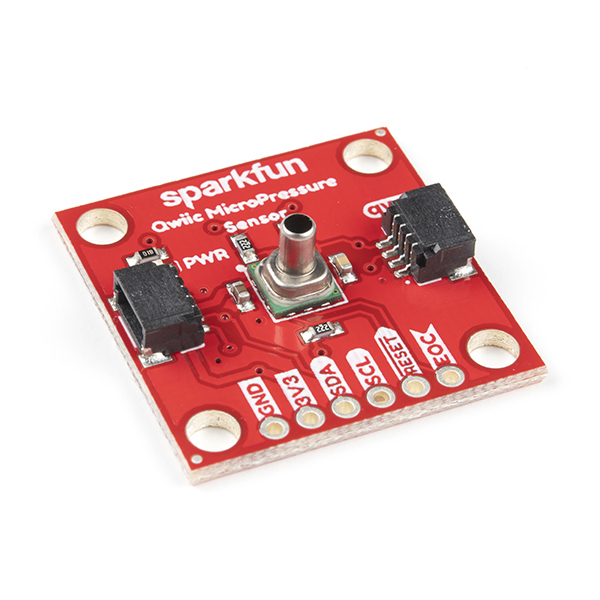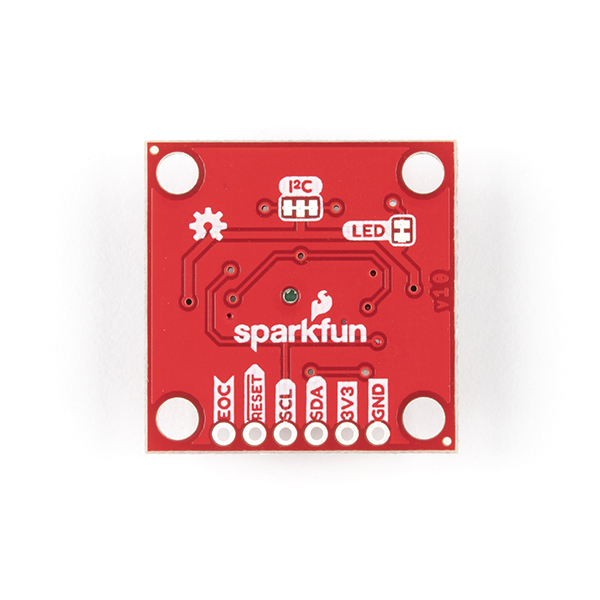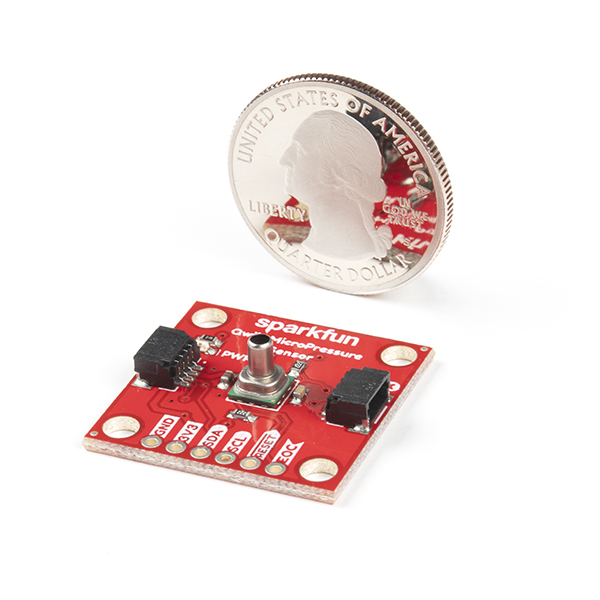SparkFun Qwiic MicroPressure Sensor
The SparkFun Qwiic MicroPressure Sensor is a miniature breakout equipped with Honeywell's 25psi piezoresistive silicon pressure sensor. This MicroPressure Sensor offers a calibrated and compensated pressure sensing range of 60mbar to 2.5bar, easy to read 24 bit digital I2C output, and can be calibrated and compensated over a specific temperature range for sensor offset, sensitivity, temperature effects, and non-linearity using an on-board Application Specific Integrated Circuit (ASIC). With its ultra-low power consumption and Qwiic ports, you've got yourself a power packed little sensor!
Each Qwiic MicroPressure Sensor has a calibrated pressure sensing range from 1-25psi and a power consumption rate as low as 0.01mW typ. average power, 1Hz measurement frequency for ultimate portability. Used in multiple medical (blood pressure monitoring, negative pressure wound therapy), industrial (air braking systems, gas and water meters), and consumer uses (coffee machines, humidifiers, air beds, washing machines, dishwashers), the SparkFun Qwiic MicroPressure Sensor is a great addition to the SparkFun Qwiic ecosystem!
The SparkFun Qwiic Connect System is an ecosystem of I2C sensors, actuators, shields and cables that make prototyping faster and less prone to error. All Qwiic-enabled boards use a common 1mm pitch, 4-pin JST connector. This reduces the amount of required PCB space, and polarized connections mean you can’t hook it up wrong.
- Pressure Type: Absolute
- Operating Pressure: 25psi (172.37kPa)
- I2C Address: 0x18
- Accuracy: ±0.25%
- Voltage - Supply: 1.8V-3.6V
- Port Size: Male - 0.1" (2.5mm) Tube
- Port Style: Barbless
- Maximum Pressure: 60psi (413.69kPa)
- Compatible with a variety of liquid media
- 2x Qwiic Connectors
- Schematic
- Eagle Files
- Board Dimensions
- Hookup Guide
- Datasheet (MPR Series - MPRLS0025PA00001A)
- Qwiic Resource Page
- Arduino Library
- GitHub Hardware Repo
SparkFun Qwiic MicroPressure Sensor Product Help and Resources
SparkFun Qwiic MicroPressure Hookup Guide
July 23, 2020
Get started using your Qwiic MicroPressure breakout board with this hookup guide.
Measuring Height with Atmospheric Pressure
September 29, 2022
Measure height using atmospheric pressure with your Qwiic MicroPressure breakout board!
Core Skill: Programming
If a board needs code or communicates somehow, you're going to need to know how to program or interface with it. The programming skill is all about communication and code.
Skill Level: Rookie - You will need a better fundamental understand of what code is, and how it works. You will be using beginner-level software and development tools like Arduino. You will be dealing directly with code, but numerous examples and libraries are available. Sensors or shields will communicate with serial or TTL.
See all skill levels
Core Skill: Electrical Prototyping
If it requires power, you need to know how much, what all the pins do, and how to hook it up. You may need to reference datasheets, schematics, and know the ins and outs of electronics.
Skill Level: Rookie - You may be required to know a bit more about the component, such as orientation, or how to hook it up, in addition to power requirements. You will need to understand polarized components.
See all skill levels
Comments
Looking for answers to technical questions?
We welcome your comments and suggestions below. However, if you are looking for solutions to technical questions please see our Technical Assistance page.
Customer Reviews
5 out of 5
Based on 1 ratings:
Awesome Pressure Sensor
The metal nozzle allows for easy air-line tubing to be attached. Furthermore, the raw values have less noise and drift than the bmp pressure sensor series.





It doesn't look like i can't formally review this, as i had "Purchasing" buy it at work instead of buying it myself from home.
5 stars! Easy to use, very steady output - not noisy like other sensors i have used. Nice! We are tracking vacuum around 0.4 psia and it seems reliable so far.
Hi,
I am doing a project with vacuum to create around 0 psia. But could not reach less than 3 psia. Which vacuum pump are you using?
Thank you
Hi, Sorry i don't know! It's some beastly industrial thing at work. It has it has a backup twin and their own room. Mark
I'm going to leave a really unhelpful reply until I dig out my old computer and find the fixed code. There's a really inefficient delay in the library that doesn't become evident until you are trying to use more than one of these sensors with an I2C mux. I needed to measure multiple pressure points in a fluid circuit at the same time, so I had three of these through an I2C mux. The culprit is in the .cpp library:
The whole program halts while it's delayed in this waiting loop. And, at least based on my experience, it goes through this loop 50 or so times before the sensor is ready to read data. It's not a big deal for one sensor, but when you have three sensors that you're trying to read in sequence, it slows down the sampling rate by 1/3. Using the stock code, you're waking up one sensor to request data and then sit there waiting for it to respond. You get it and then move on to the next sensor. The fix, if using multiple sensors, is to not wait up in the loop but zip through all the sensors, interrogating them for an update, and then cycle back through to see if it's ready so you can do the whole thing in parallel.
@Sparkfun, would it be better to post my change here in the comments, send it directly to you, or do something in Github?
I found CircuitPython code that can be used with it. Works well: https://learn.adafruit.com/adafruit-mprls-ported-pressure-sensor-breakout
RECOMMENDATION: I have one of these sensors and the Qwiic connector didn't work ... It only works with 12C pins (SDA and SCL) ... it's very precise and useful, and you just have to correct the Qwiic connector
@guillengap can you explain what the issue was? I'm not able to communicate with the QWIC connector. I can see SDA and SCL on the test pins on the board via a scope, so it seems like it's getting the right signal. I've gone through the Tech Forum, but thought I'd ask here too since you brought up the issue, thanks.
My QWICC connector doesn't communicate ... you can solder the pins GND, 3V3, SDA, SCL ... then connect them directly to the artemis board, Arduino UNO, etc and use the same libraries and examples of DOCUMENTS or: https://learn.sparkfun.com/tutorials/sparkfun-qwiic-micropressure-hookup-guide?_ga=2.85588889.1077246316.1611532025-1736339105.1600121553
You should say which exact sensor is on the BoB. From the data sheet there are 31x9x3 possibilities. I'm guessing it's the MPRLS0025PA 0000 1 x (don't know the transfer function) based on the text. But, I hate guessing when it comes to electronics. Please be explicit.
Sorry about that! The documents section has been updated to include the IC part number used on the breakout board by another representative.